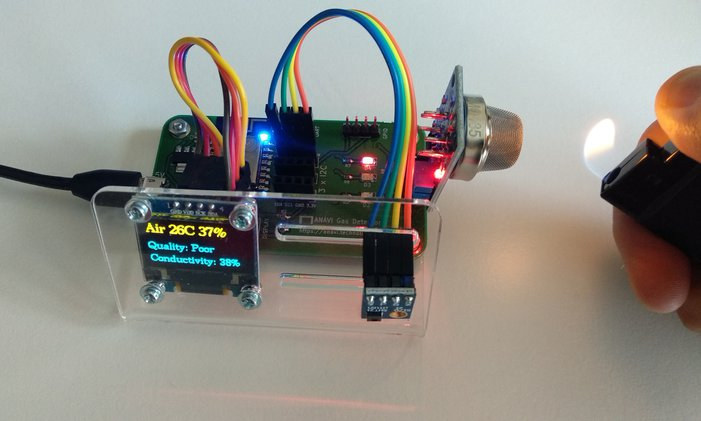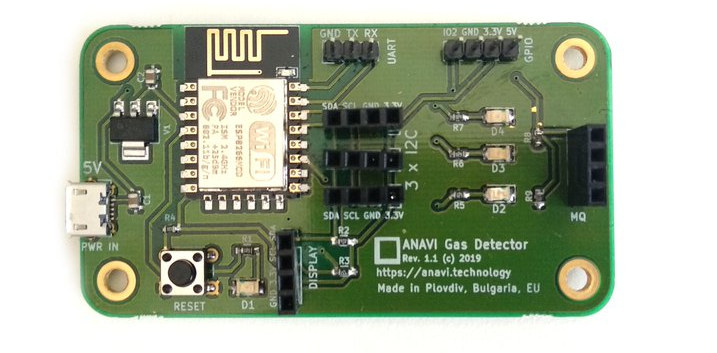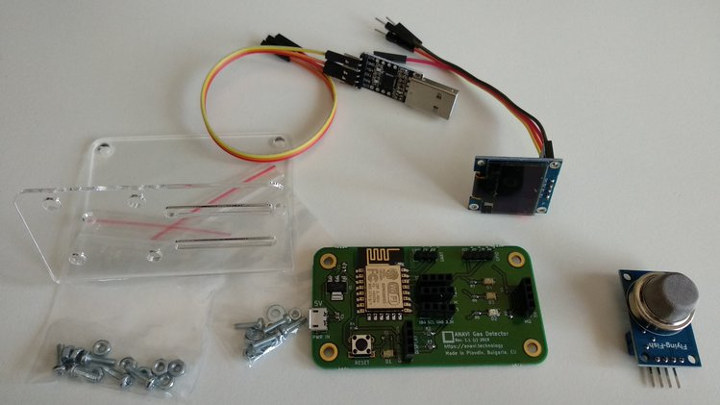Leon ANAVI is a software engineer with an interest in open-source hardware, and he had previously launched several ANAVI boards for home automation based on Espressif ESP8266 or for Raspberry Pi boards including ANAVI thermometer, ANAVI light controller, and ANAVI Infrared pHAT among others.
Leon has now introduced a new board on Crowd Supply: ANAVI gas detector. The board is powered by ESP8266 WiSoC providing WiFI connectivity, and supports MQ gas sensor modules such as MQ-135, MQ-2, or MQ-3 in order to monitor air quality and detect gas leaks.
 ANAVI gas detector board specifications:
ANAVI gas detector board specifications:
- Wireless Module – Based on ESP8266 Tensilica L106 32-bit processor with Wi-Fi 4 802.11 b/g/n connectivity
- Display – Optional Mini OLED display
- Gas sensor support – MQ-135 for air quality or any other 5V MQ analog gas sensor
- Expansion – 3x slots for I²C sensors
- Debugging / Programming – UART pins for flashing custom firmware
- Misc – Button
- Power Supply – 5V via micro USB port
- Dimensions – 75 mm x 40 mm
- Certifications – Open Source Hardware Association (OSHWA) BG000018
 ANAVI Gas Detector works with the Arduino IDE, PlatformIO, as well as the popular open-source home automation platforms such as Home Assistant and OpenHAB via MQTT protocol. You’ll find the KiCad schematics and PCB layout on Github, as well as an Arduino code sample, and documentation. The latter still needs to be updated since it’s still about the earlier ANAVI Thermometer board 🙂
ANAVI Gas Detector works with the Arduino IDE, PlatformIO, as well as the popular open-source home automation platforms such as Home Assistant and OpenHAB via MQTT protocol. You’ll find the KiCad schematics and PCB layout on Github, as well as an Arduino code sample, and documentation. The latter still needs to be updated since it’s still about the earlier ANAVI Thermometer board 🙂
MQ-135 sensor can be purchased as part of the some of the kits, but if you’d like to get your own sensors, any of the following should work:
- MQ-135 for air quality
- MQ2 for methane, butane, LPG, smoke
- MQ-3 for alcohol, ethanol, smoke
- MQ-7 for carbon monoxide
- MQ-9 for carbon monoxide and flammable gasses
 The campaign had a $10 funding target which obviously has already been surpassed. Rewards start at $25 for the board only, but most people will likely go with the $39 starter kit that adds an acrylic case, OLED mini display, MQ-135 gas sensor module, and USB to UART debug cable in order to get started out of the box. There are other perks with more sensors as well. Shipping is free to the US, and adds $12 to the rest of the world. The boards and kits are expected to start shipping on November 22nd.
The campaign had a $10 funding target which obviously has already been surpassed. Rewards start at $25 for the board only, but most people will likely go with the $39 starter kit that adds an acrylic case, OLED mini display, MQ-135 gas sensor module, and USB to UART debug cable in order to get started out of the box. There are other perks with more sensors as well. Shipping is free to the US, and adds $12 to the rest of the world. The boards and kits are expected to start shipping on November 22nd.

Jean-Luc started CNX Software in 2010 as a part-time endeavor, before quitting his job as a software engineering manager, and starting to write daily news, and reviews full time later in 2011.
Support CNX Software! Donate via cryptocurrencies, become a Patron on Patreon, or purchase goods on Amazon or Aliexpress




